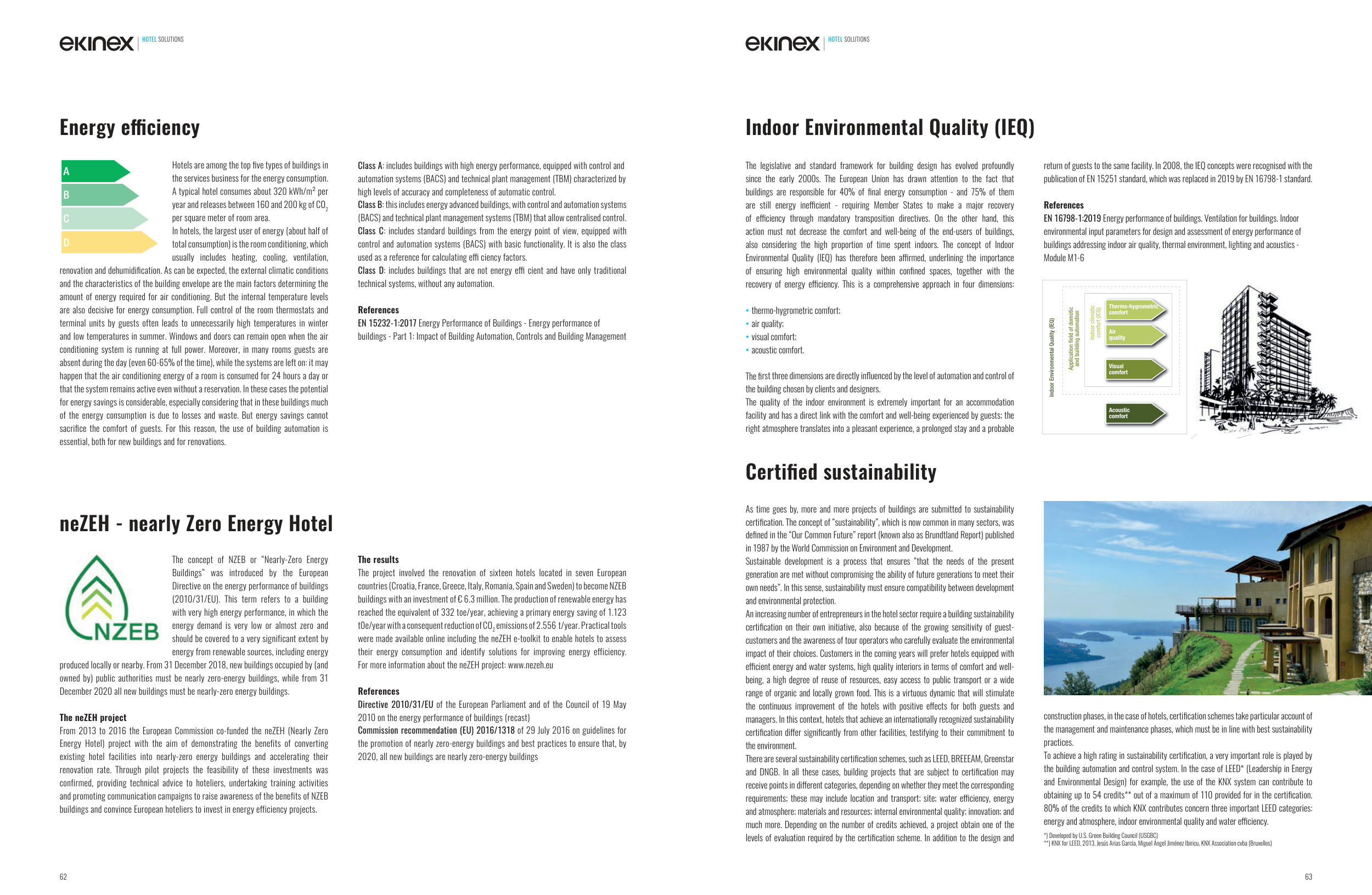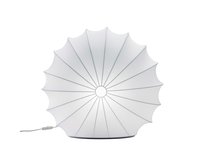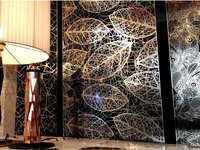Hotels are among the top fi ve types of buildings in
the services business for the energy consumption.
A typical hotel consumes about 320 kWh/m² per
year and releases between 160 and 200 kg of CO2
per square meter of room area.
In hotels, the largest user of energy (about half of
total consumption) is the room conditioning, which
usually includes heating, cooling, ventilation,
renovation and dehumidifi cation. As can be expected, the external climatic conditions
and the characteristics of the building envelope are the main factors determining the
amount of energy required for air conditioning. But the internal temperature levels
are also decisive for energy consumption. Full control of the room thermostats and
terminal units by guests often leads to unnecessarily high temperatures in winter
and low temperatures in summer. Windows and doors can remain open when the air
conditioning system is running at full power. Moreover, in many rooms guests are
absent during the day (even 60-65% of the time), while the systems are left on: it may
happen that the air conditioning energy of a room is consumed for 24 hours a day or
that the system remains active even without a reservation. In these cases the potential
for energy savings is considerable, especially considering that in these buildings much
of the energy consumption is due to losses and waste. But energy savings cannot
sacrifi ce the comfort of guests. For this reason, the use of building automation is
essential, both for new buildings and for renovations.
Class A: includes buildings with high energy performance, equipped with control and
automation systems (BACS) and technical plant management (TBM) characterized by
high levels of accuracy and completeness of automatic control.
Class B: this includes energy advanced buildings, with control and automation systems
(BACS) and technical plant management systems (TBM) that allow centralised control.
Class C: includes standard buildings from the energy point of view, equipped with
control and automation systems (BACS) with basic functionality. It is also the class
used as a reference for calculating effi ciency factors.
Class D: includes buildings that are not energy effi cient and have only traditional
technical systems, without any automation.
References
EN 15232-1:2017 Energy Performance of Buildings - Energy performance of
buildings - Part 1: Impact of Building Automation, Controls and Building Management
A
B
C
D
Energy effi ciency
The concept of NZEB or “Nearly-Zero Energy
Buildings” was introduced by the European
Directive on the energy performance of buildings
(2010/31/EU). This term refers to a building
with very high energy performance, in which the
energy demand is very low or almost zero and
should be covered to a very significant extent by
energy from renewable sources, including energy
produced locally or nearby. From 31 December 2018, new buildings occupied by (and
owned by) public authorities must be nearly zero-energy buildings, while from 31
December 2020 all new buildings must be nearly-zero energy buildings.
The neZEH project
From 2013 to 2016 the European Commission co-funded the neZEH (Nearly Zero
Energy Hotel) project with the aim of demonstrating the benefits of converting
existing hotel facilities into nearly-zero energy buildings and accelerating their
renovation rate. Through pilot projects the feasibility of these investments was
confirmed, providing technical advice to hoteliers, undertaking training activities
and promoting communication campaigns to raise awareness of the benefits of NZEB
buildings and convince European hoteliers to invest in energy efficiency projects.
The results
The project involved the renovation of sixteen hotels located in seven European
countries (Croatia, France, Greece, Italy, Romania, Spain and Sweden) to become NZEB
buildings with an investment of € 6.3 million. The production of renewable energy has
reached the equivalent of 332 toe/year, achieving a primary energy saving of 1.123
t0e/year with a consequent reduction of CO2 emissions of 2.556 t/year. Practical tools
were made available online including the neZEH e-toolkit to enable hotels to assess
their energy consumption and identify solutions for improving energy efficiency.
For more information about the neZEH project: www.nezeh.eu
References
Directive 2010/31/EU of the European Parliament and of the Council of 19 May
2010 on the energy performance of buildings (recast)
Commission recommendation (EU) 2016/1318 of 29 July 2016 on guidelines for
the promotion of nearly zero-energy buildings and best practices to ensure that, by
2020, all new buildings are nearly zero-energy buildings
neZEH - nearly Zero Energy Hotel
As time goes by, more and more projects of buildings are submitted to sustainability
certifi cation. The concept of “sustainability”, which is now common in many sectors, was
defi ned in the “Our Common Future” report (known also as Brundtland Report) published
in 1987 by the World Commission on Environment and Development.
Sustainable development is a process that ensures “that the needs of the present
generation are met without compromising the ability of future generations to meet their
own needs”. In this sense, sustainability must ensure compatibility between development
and environmental protection.
An increasing number of entrepreneurs in the hotel sector require a building sustainability
certifi cation on their own initiative, also because of the growing sensitivity of guest-
customers and the awareness of tour operators who carefully evaluate the environmental
impact of their choices. Customers in the coming years will prefer hotels equipped with
effi cient energy and water systems, high quality interiors in terms of comfort and well-
being, a high degree of reuse of resources, easy access to public transport or a wide
range of organic and locally grown food. This is a virtuous dynamic that will stimulate
the continuous improvement of the hotels with positive eff ects for both guests and
managers. In this context, hotels that achieve an internationally recognized sustainability
certifi cation diff er signifi cantly from other facilities, testifying to their commitment to
the environment.
There are several sustainability certifi cation schemes, such as LEED, BREEEAM, Greenstar
and DNGB. In all these cases, building projects that are subject to certifi cation may
receive points in diff erent categories, depending on whether they meet the corresponding
requirements; these may include location and transport; site; water effi ciency, energy
and atmosphere; materials and resources; internal environmental quality; innovation; and
much more. Depending on the number of credits achieved, a project obtain one of the
levels of evaluation required by the certifi cation scheme. In addition to the design and
construction phases, in the case of hotels, certifi cation schemes take particular account of
the management and maintenance phases, which must be in line with best sustainability
practices.
To achieve a high rating in sustainability certifi cation, a very important role is played by
the building automation and control system. In the case of LEED* (Leadership in Energy
and Environmental Design) for example, the use of the KNX system can contribute to
obtaining up to 54 credits** out of a maximum of 110 provided for in the certifi cation.
80% of the credits to which KNX contributes concern three important LEED categories:
energy and atmosphere, indoor environmental quality and water effi ciency.
*) Developed by U.S. Green Building Council (USGBC)
**) KNX for LEED, 2013, Jesús Arias García, Miguel Ángel Jiménez Ibiricu, KNX Association cvba (Bruxelles)
The legislative and standard framework for building design has evolved profoundly
since the early 2000s. The European Union has drawn attention to the fact that
buildings are responsible for 40% of fi nal energy consumption - and 75% of them
are still energy ineffi cient - requiring Member States to make a major recovery
of effi ciency through mandatory transposition directives. On the other hand, this
action must not decrease the comfort and well-being of the end-users of buildings,
also considering the high proportion of time spent indoors. The concept of Indoor
Environmental Quality (IEQ) has therefore been affi rmed, underlining the importance
of ensuring high environmental quality within confi ned spaces, together with the
recovery of energy effi ciency. This is a comprehensive approach in four dimensions:
• thermo-hygrometric comfort;
• air quality;
• visual comfort;
• acoustic comfort.
The fi rst three dimensions are directly infl uenced by the level of automation and control of
the building chosen by clients and designers.
The quality of the indoor environment is extremely important for an accommodation
facility and has a direct link with the comfort and well-being experienced by guests; the
right atmosphere translates into a pleasant experience, a prolonged stay and a probable
return of guests to the same facility. In 2008, the IEQ concepts were recognised with the
publication of EN 15251 standard, which was replaced in 2019 by EN 16798-1 standard.
References
EN 16798-1:2019 Energy performance of buildings. Ventilation for buildings. Indoor
environmental input parameters for design and assessment of energy performance of
buildings addressing indoor air quality, thermal environment, lighting and acoustics -
Module M1-6
Indoor Environmental Quality (IEQ)
Certifi ed sustainability
Thermo-hygrometric
comfort
Indoor climatic
comfort (ICQ)
Application feld of domotic
and building automation
Indoor Environmental Quality (IEQ)
Air
quality
Visual
comfort
Acoustic
comfort
HOTEL SOLUTIONS
HOTEL SOLUTIONS
62
63








































